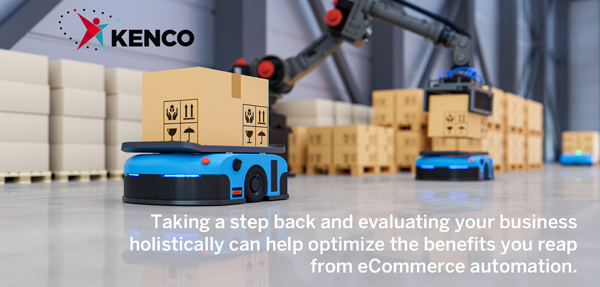Today’s volatile marketplace has altered the way we value and justify automation investments in the eCommerce supply chain landscape. Historically, automation usually required cost justification, meaning in order to pay for equipment, software, or a robotic system, you’d have to offset operational costs with a payback worth the investment. The principal question was “How fast is my ROI?” and it was common for automation to need to run 24/7 for it to make sense.
The way we evaluate return on investment and key KPIs has shifted. There are different drivers besides just cost that help to justify automation presently. The goal of eCommerce automation investments today is more about working alongside employees to standardize output and the quality of processes for online commerce. There are many challenges in the supply chain—from bottlenecks to labor shortages and warehouse capacity constraints—that can hinder or altogether stop companies from getting their products to customers. This makes reliability, scalability, and security more important than ever before.
With automation, there are ways in which you improve performance on stability of service and customer experience which might not cost justify in the same way as previously but may be required to accomplish business objectives. Taking a step back and evaluating your business holistically can help optimize the benefits you gain from automation. Below are three ways to see return on our eCommerce automation investment:
1. Develop a Consistent Standard Process that Ensures Confidence
Individuals perform tasks with different speeds, styles, methods, and levels of accuracy. Even after implementing process best practices, it’s impossible to guarantee a team of people will complete every task in the same exact way, resulting in margin for discrepancies and error. When set up correctly, automation can eliminate that risk and replace it with confidence in performance output. By implementing the consistency and standardization that only automation can provide, you can create a dependable process and service level. Standardizing certain routine processes also empowers employees with more time to perform valuable tasks that require deeper thought and can’t be automated. These are very important long-term benefits of automation.
2. Scale Business Processes Up and Down with Ease
Amid our nation’s current supply chain labor crisis, it can be much more expensive and time-consuming to find additional people than it is to modify the speed of an automated workflow. There can be a lot of risk associated with relying solely on human labor to get your products out to customers, especially as volume fluctuates throughout the year. Luckily, automation can supplement your existing workforce to help reach your business goals faster. Automated software and robotic solutions save you time and allow businesses to easily scale up and down with the flow of product. Of course, automation is heavily dependent upon product profiles and attributes, and some automation is more scalable than others, so it’s important to do your research beforehand.
3. Leave Breathing Room for Continuous Supply Chain Improvement
There will always be a need for people to manage different aspects of operations, from inventory management to all functions within a facility flow. By automating parts of that flow, you free up bandwidth for employees to focus on other aspects of the business. As a result, you have the opportunity to focus on continuous improvement in areas outside of the automation and improve the overall capability of the operation. There are a lot of variables that go into distributing products and performing process steps within a warehouse (and the supply chain in general), so having fewer areas to focus on can lead to much better results.
Finding the Right Automation Investments for Your Business Needs
Automation within supply chain is far from one-size-fits-all. Because we’re in a technological era with significant innovation, the market is extremely saturated with many types of solutions that fit different needs. The right automation investment for your business will depend on your company’s profile, volume threshold, flow of product throughout the year, budget, workforce, and other factors. Given today’s redefining of what makes an automation investment worthwhile, a cost-benefit analysis is only part of the picture when considering automation, and you need to understand specific business requirements and KPIs.
For businesses looking to integrate more automation into their end-to-end supply chain, the best bet is to find a trusted partner to guide you through the process. At Kenco, we have a dedicated team of continuous improvement experts and long-standing tenure with many diverse eCommerce and omni-channel customers. We are able to pilot new technologies for customers and test automation solutions in different scenarios to ensure they will deliver value in action. In some cases, Kenco has even invested in automation on behalf of our customers. To learn more about Kenco’s thought leadership approach and how we can help add automation into your supply chain, visit our eCommerce and Fulfillment page.


